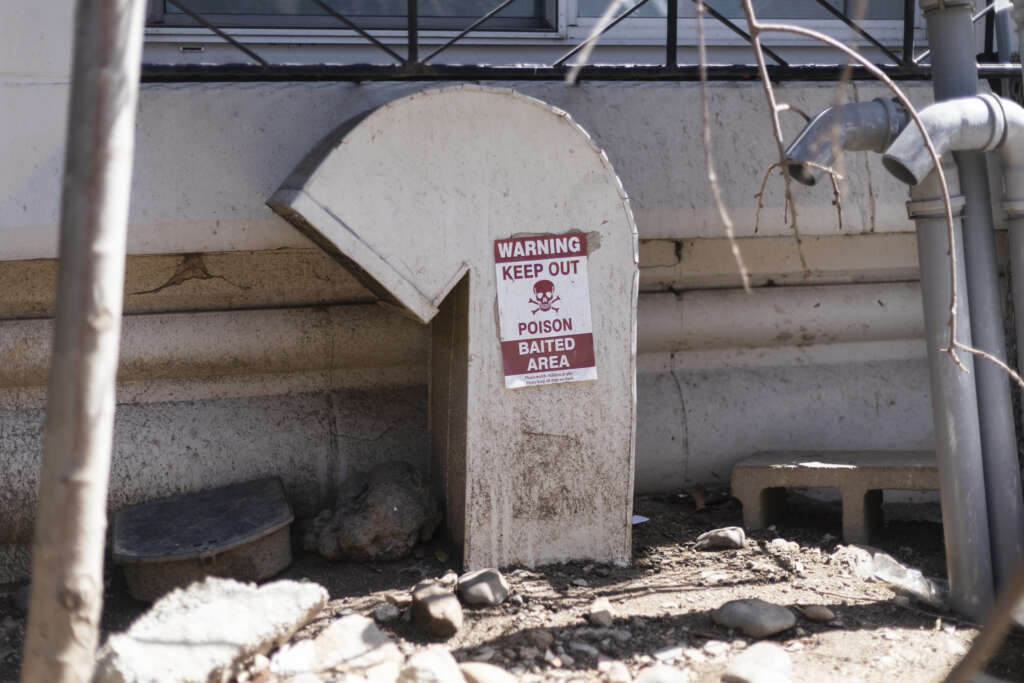“A system that centralizes fines ignores two crucial facts about our rodent crisis: rats do not abide by property boundaries and many homeowners are asset rich but cash poor, and do not have the resources to pay for either the fine or the requested intervention.”
A rat poison on the building in Brooklyn. (Emil Cohen/NYC Council Media Unit)
If there’s one thing every New Yorker hates, it’s rats. And coming in at a close second is the ubiquitous orange envelope tucked under their windshield wiper or a summons number with a hearing date posted on their door.
We’re a city of dreamers and hustlers; being a New Yorker is synonymous with fighting for one’s goals and not stopping at any cost. But there are times in our relentless pursuit of the New York hustle when we mess up and forget to move our car for the street sweeper or put our trash out too early. That’s when we find ourselves facing fines.
Fines have a place in any modern city. If utilized properly and equitably, they could ensure proper compliance with a number of laws that otherwise would go unheeded. But in some cases, fines unfairly penalize hardworking New Yorkers without fixing the underlying issue.
Rats are a part of the cultural fabric of New York. We have rats of all shapes and sizes: pizza rat, street performer rat (who happens to be a District 35 resident), and inflatable protest rats. We have so many rats that our city had to appoint its very own Rat Czar (who also happens to be a District 35 resident) to help handle our growing crisis. But our city has largely used a single tool to manage a crisis that has spanned generations: fines.
The health department uses fines in an attempt to persuade property owners to enact strong rodent mitigation protocol on their property. But as city data shows, fines alone don’t solve the problem. In Brooklyn, the city issued 63 percent more rodent summonses for the last half of 2023 compared to the first half, but rodent sightings still remain strong.
RELATED READING: Crown Heights Homeowners Say They’re Bearing the Brunt of Mayor Adams’ War on Rats
While fines can help keep tenants safe from hazardous building conditions due to negligent landlords or curb dangerous driving, they aren’t the answer for keeping our rat population down for some smaller properties. A system that centralizes fines ignores two crucial facts about our rodent crisis: rats do not abide by property boundaries and many homeowners are asset rich but cash poor, and do not have the resources to pay for either the fine or the requested intervention.
This means a homeowner could receive a $2,000 fine for a perceived repeated rodent infestation if gnaw marks or rat droppings were identified at a property even if rats just ran by that building and have no burrows nearby. That both dissuades residents from calling 311 for fear of unfairly securing a hefty fine for their neighbors and leads to dissatisfaction with the city’s response to rodent infestations since the problem never gets addressed. (Not to mention that many New Yorkers never even pay their fines, fines are largely levied against Black and brown homeowners, and enforcement sometimes costs more than the city gets back in fines.)
It’s clear that our strategy of relying on sticks alone to solve our rat problem has not worked. Now, the city must instead turn toward carrots and provide solutions rather than punishment. This vision drove us to co-establish the District 35 Rat Task Force, which convenes constituents, block associations, and agency officials to share best practices to address existing rodent infestations and prevent them in the future.
We’ve succeeded in securing funding for rat-proof litter bins, supplemental sanitation services, carbon monoxide treatments, and greater educational materials.There are a number of common sense, non-punitive solutions we can secure to reduce our city’s rat population such as education and advocacy to share best practices and push the city to invest in systems that address the root causes of rodent outbreaks, like easy access to food.
The largest variable in rat infestations is the availability of food. Rats only need an ounce of food per day, and food for a rat could mean anything from litter to dog waste to garbage. Thankfully, our city already has tools to stop this: mandatory curbside composting and residential waste containerization.
We must continue to increase compliance with organics recycling laws and ensure every building separates out organics waste. We must continue expanding our push to containerize all residential waste, including by passing our bill to mandate on-street containers for large residential buildings. And the city should consider tax breaks or other financial benefits for properties that abide by these programs, even if there’s a rat sighting or two, to show property owners that the city understands they’re doing everything in their power to fight back against our growing rat population and thank them for their cooperation.
In a time when trust in government is at a near historic low, we have an opportunity to show New Yorkers what effective governance looks like. Let’s stop focusing on penalizing hard-working New Yorkers and instead invest in solutions that work and support our neighbors who are doing the right thing.
Crystal Hudson is the councilmember for District 35 and submitted this oped in coordination with the District 35 Rat Task Force. Established in 2022, the District 35 Rat Task Force is a group of residents who share resources, advocate for policy changes, and organize to stop rodent infestations in Crown Heights, Prospect Heights, Fort Greene, and Clinton Hill.
The post Opinion: One Way To Stop The Rats? Turn Away From Fines. appeared first on City Limits.

